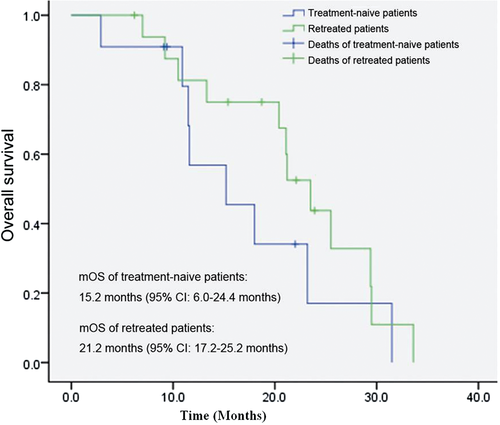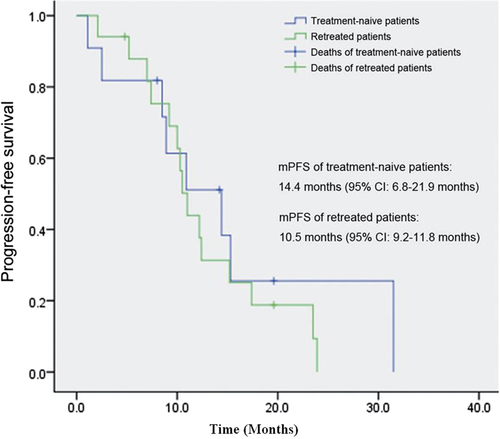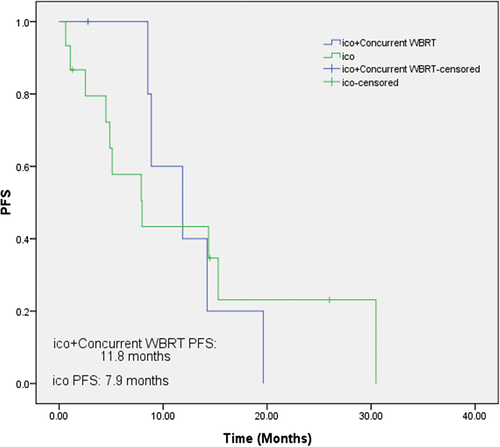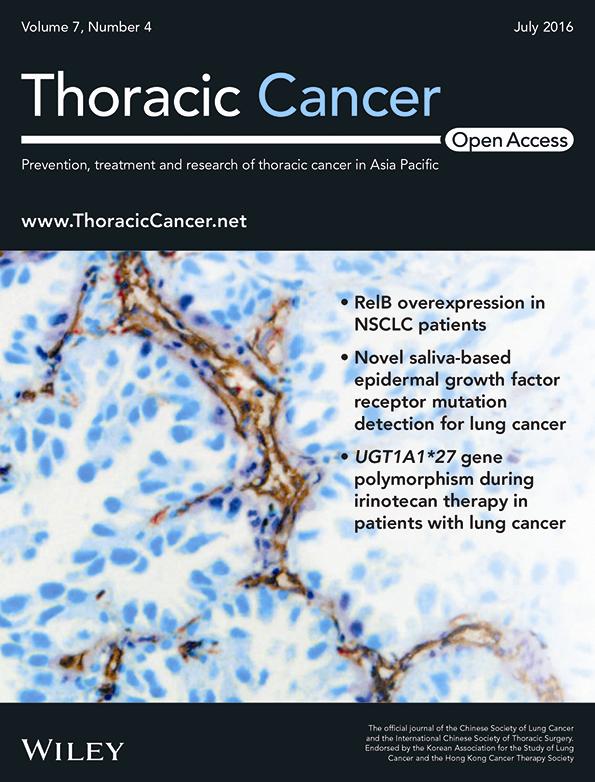Icotinib as initial treatment in lung adenocarcinoma patients with brain metastases
Abstract
Background
To evaluate the antitumor activity and toxicity of icotinib as initial treatment in lung adenocarcinoma patients with brain metastases.
Methods
Twenty-one patients with histologically or pathologically documented brain metastatic lung cancer were administered icotinib as initial treatment from 2011 to 2015 at the Cancer Institute and Hospital, Chinese Academy of Medical Sciences. Chemotherapy response was assessed by Response Evaluation Criteria in Solid Tumors and toxicity was evaluated according to National Cancer Institute-Common Toxicity Criteria. Icotinib was administered three times per day at a dose of 125mg.
Results
The median overall and progression-free survival rates were 15.2 (1.2–31.5 months, 95% confidence interval [CI] 6.6–23.7 months) and 8.9 months (0.6–30.5 months, 95% CI 3.4–14.3 months), respectively. The overall response and disease control rates were 61.9% and 90.5%, respectively. Icotinib was well tolerated, and no grade 3/4 adverse events were observed. The most common grade 1/2 adverse events included acneiform eruptions (38.1%), diarrhea (19.0%), and stomatitis (9.5%).
Conclusion
Icotinib is effective and well tolerated as initial treatment in lung adenocarcinoma patients with brain metastases.
Introduction
The lung cancer incidence rate (46.08/100 000) ranked first among all malignant tumors in China in 2011, accounting for 19.59% of all malignant tumors; there were 610 000 newly diagnosed cases of lung cancer. The lung cancer mortality rate also ranked first among all malignant tumors, accounting for 24.87% of all cancer deaths in 2011. Approximately 490 000 patients die of lung cancer every year and, in 2011, the mortality rate was 37.00/100 000.1, 2 With the continuous development of tumor molecular biological studies, great success has been achieved in targeted therapy and immunotherapy for advanced lung cancer, particularly lung adenocarcinoma, which has provided more choices for clinical treatment, prolonged progression-free survival (PFS) and overall survival (OS), and improved patient quality of life. Brain metastasis is a common metastasis of advanced lung cancer, suggesting poor prognosis. In recent years, a series of driver mutations related to the occurrence and development of cancer have been found, and the protein products of these mutations have been used as therapeutic targets to perform individualized targeted therapy. To date, most research has been conducted on epidermal growth factor receptor (EGFR), a therapeutic target already widely used in clinical practice. Icotinib is a small-molecular EGFR-tyrosine kinase inhibitor (TKI) independently developed in China. Clinical studies have shown that it is safe and effective for lung cancer patients with EGFR sensitive mutations.3
Methods
From August 2011 to August 2015, 21 lung adenocarcinoma patients with brain metastases received icotinib (Conmana, Betta Pharmaceuticals Co. Ltd., Hangzhou, Zhejiang) as initial treatment at the Cancer Institute and Hospital, Chinese Academy of Medical Sciences. Three patients were men and 18 were women. The median age was 60 years (37–77): 11 patients were under the age of 60, 10 patients were above the age of 60. None of the patients had a smoking history. The pathological type in all patients was lung adenocarcinoma. Twelve patients had EGFR sensitive mutations (exon 19 deletion and 21 point) and nine patients had unknown EGFR mutation status. All of the nine patients with unknown EGFR mutation status were women, without a smoking history, and a median age of 60 years (43–77). None of the patients had previously been treated with icotinib and were diagnosed with brain metastases before taking icotinib. Among them, six patients simultaneously received whole-brain radiation therapy (WBRT, γknife) during treatment with icotinib. Of these six patients, one had unknown EGFR mutation status, and five had EGFR sensitive mutations (exons 19 or 21). Fifteen patients received single initial treatment with icotinib. Of these 15, eight patients had unknown EGFR mutation status and seven had EGFR sensitive mutations (exons 19 or 21).
Treatment regimen
Icotinib was orally administered three times per day at a dose of 125 mg until disease progression or occurrence of intolerable side effects.
Evaluation criteria
Response Evaluation Criteria in Solid Tumors 1.0 was used to evaluate efficacy, which was classified into complete response (CR), partial response (PR), stable disease (SD) and progressive disease (PD). PFS was defined as the date of the first icotinib treatment to the date when tumor progression was found in imaging examinations for the first time. OS was defined as the date of the first day of treatment with icotinib to the date of death or last follow-up. Toxicity was evaluated according to National Cancer Institute-Common Toxicity Criteria 4.0.
Statistical analysis
Categorical variables were analyzed using percentage method and continuous variables were analyzed using median method. Survival was analyzed using the Kaplan–Meier method. SPSS 19.0 (IBM Corp., Armonk, NY, USA) was chosen as the statistical software.
Results
Objective response and survival
The final follow-up of the study was performed on 30 August 2015. The median follow-up period was 14.9 months. Of the patients included in the study, 11 died, 10 survived, 16 suffered from disease progression, and five did not experience disease progression. For all 21 patients in the study, the median OS was 15.2 months (1.2–31.5 months, 95% CI 6.6–23.7 months), the median PFS was 8.9 months (0.6–30.5 months, 95% CI 3.4–14.3 months), the response rate (RR) was 61.9% and the disease control rate (DCR) was 90.5%.
In subgroup analysis, the median OS rates for the patients with EGFR sensitive mutations and the patients with unknown EGFR mutation status were 23.2 and 10.9 months (P = 0.0002), respectively. The median PFS rates were 15.3 and 4.9 months (P = 0.008), respectively. As shown in Table 1, the median OS and PFS rates of the 12 patients with EGFR sensitive mutations were 23.2 (1.3–31.5 months, 95% CI 7.7–38.8 months) and 15.3 months (1.3–30.1 months, 95% CI 12.8–17.8 months), respectively. The RR and DCR were 75% and 100%, respectively (see Fig 1). The median OS and PFS rates of the nine patients with unknown EGFR mutation status were 10.9 (1.2–18.0 months, 95% CI 0.3–21.5 months) and 4.9 months (0.6–14.4 months, 95% CI 3.8–5.9 months), respectively. The RR and DCR were 44.4% and 77.8%, respectively (see Fig 2).
| Number of cases (n = 21) | Simple drug treatment (n = 15) | Drug + WBRT (n = 6) |
|---|---|---|
| Patients with EGFR sensitive mutation | 7 | 5 |
| Response rate (%) | 46.7 | 100 |
| Disease control rate (%) | 86.7 | 100 |
| Unknown EGFR mutation status | 8 | 1 |
| Response rate (%) | 75 | 44.4 |
| Disease control rate (%) | 100 | 77.8 |
- EGFR, epidermal growth factor receptor; WBRT, whole brain radiation therapy.


The difference in median OS and PFS rates between the patients who received icotinib combined with radiotherapy and the patients who received icotinib alone was not statistically significant. The median OS and PFS rates of the six treatment-naive patients receiving icotinib combined with WBRT as initial treatment were 15.2 (2.8–22.0 months, 95% CI 9.6–20.7 months) and 11.8 months (2.8–19.6 months, 95% CI 5.4–18.3 months), respectively (see Fig 3); both the RR and DCR were 100%. The median OS and PFS rates of the 15 patients receiving icotinib monotherapy as initial treatment were 18.0 (1.2–31.5 months, 95% CI 4.7–31.3 months) and 7.9 months (2.1–23.9 months, 95% CI 2.8–13.1 months), respectively; the RR and DCR were 46.7% and 86.7%, respectively (see Fig 4).


Adverse events
Icotinib was well tolerated and no grade 3/4 adverse events were observed. The most common grade 1/2 adverse events included eight cases of acneiform eruption (38.1%), four cases of diarrhea (19.0%) and two cases of stomatitis (9.5%), as shown in Table 2.
| Adverse events | Number of cases (n = 28) | Rate (%) |
|---|---|---|
| Acneiform eruption | 8 | 38.1 |
| Diarrhea | 4 | 19.0 |
| Stomatitis | 2 | 9.5 |
Discussion
The study results suggested that icotinib was safe and effective for the treatment of lung adenocarcinoma with brain metastases. Brain metastasis is the most common metastasis in advanced non-small cell lung cancer (NSCLC); 10–25% of patients have already suffered from central nervous system metastases at diagnosis, while 40–50% of patients develop central nervous system metastases during treatment.4 In recent years, with the development of treatment, the survival of NSCLC patients has been generally prolonged; however, the incidence of brain metastasis has also increased. Brain metastasis seriously affects patient survival and quality of life. The median OS rate in patients with brain metastases is three to six months; the median OS rate in untreated patients is only four to 11 weeks.5 Chemotherapy drug concentration in brain tissue is low and the chemotherapy drugs commonly used for lung cancer (such as taxanes, platinum, pemetrexed, and gemcitabine) and brain metastases are not sufficiently effective because of the existence of the blood–brain barrier.6-8 EGFR-TKIs (such as Tarceva and Iressa), have provided new choices for lung cancer patients with brain metastases. Preclinical studies have shown that EGFR-TKIs were effective for NSCLC brain metastases.9 Subsequent clinical studies have reported that the RR of gefitinib therapy for NSCLC brain metastases was 10–38%, with a median sustained response time of 9–13.5 months.10-12 In addition, a number of clinical studies have confirmed that erlotinib was effective for NSCLC brain metastases.13-15 Results of these clinical studies show that the ORR and PFS of NSCLC patients with brain metastases treated with EGFR-TKIs were comparable with those of patients with extracranial lesions.
Icotinib (Conmana) was the first EGFR-TKI in which the independent intellectual property rights belong to China. A phase III clinical trial (ICOGEN) confirmed the safety and efficacy of Conmana for the treatment of NSCLC.3 Recently, a phase II clinical trial reported the efficacy of icotinib combined with WBRT for Chinese lung cancer patients with advanced lung adenocarcinoma and brain metastases, regardless of EGFR status. The median OS and PFS rates were 7.0 and 14.6 months, respectively; the RR was 80.0% and the treatment was well tolerated.16 In present study, the RR and DCR of all 21 patients were 61.9% and 90.5%, respectively, which may be related to the following factors. First, all patients were treatment-naïve, that is, not previously treated with chemotherapy or other targeted therapies. Second, most of the patients included in the study were non-smoking Chinese women who were more likely to carry EGFR sensitive mutations. Third, some patients received local radiotherapy for brain metastases both before and during treatment with icotinib.
In subgroup analysis, the median OS rates of patients with EGFR sensitive mutations and those with unknown EGFR mutation status were 23.2 and 10.9 months (P = 0.0002), respectively. The median PFS rates were 15.3 and 4.9 months (P = 0.008), respectively, similar to the results of previous reports. Previous studies have suggested that EGFR-TKIs should be used to treat NSCLC patients with brain metastases and EGFR sensitive mutations, as the RR and survival were better than those of the patients with wild-type EGFR treated with EGFR-TKIs.17, 18 Park et al. reported a RR as high as 70% in 23 NSCLC patients with brain metastases and positive mutations treated with erlotinib or gefitinib.19 Another retrospective study including 69 patients reported PFS for erlotinib among patients with EGFR mutations and those with unknown mutation status of 11.7 and 5.8 months, respectively (P < 0.05), and with OS rates of 12.9 and 3.1 months, respectively (P < 0.001).18
In vitro experiments have shown that EGFR-TKIs may have a radiosensitization effect on NSCLC.20 A phase II clinical trial including 40 NSCLC patients with brain metastases combined erlotinib and WBRT, yielding a RR of 86% and an OS rate of 12 months.21 Recently, a phase II clinical trial conducted in China combined icotinib and WBRT to treat patients and reported the effective treatment of NSCLC patients with brain metastases and EGFR sensitive mutations.16 However, a phase III randomized clinical trial (Radiation Therapy Oncology Group, RTOG 0302) showed that local radiotherapy of brain metastases combined with temozolomide or erlotinib may reduce OS.22 In the present study, the median PFS rate of the patients treated with local radiotherapy of brain metastases combined with icotinib tended to be longer than that of patients treated with icotinib alone (11.8:7.9 months, P = 0.976), but this trend of prolonged PFS could not achieve survival benefits and tended to reduce median OS (15.2:18.0 months, P = 0.985). However, this result may be caused by statistical differences as a result of the retrospective nature of this study and the small sample size.
In terms of adverse events, the study suggested that icotinib was a safe treatment method. No liver function impairment was observed in any of the patients. Only nine patients (32.1%) suffered from grade 1/2 acneiform eruption, five (17.9%) from grade 1/2 diarrhea and one patient (3.6%) suffered grade 1/2 stomatitis.
Clinically, the first generation of EGFR-TKIs (erlotinib and gefitinib), have been widely used and much clinical research data is available. In contrast, icotinib has been marketed for a shorter time; therefore, clinical data is relatively scarce with a series of issues necessary to be explored, for example, what is the initial choice for symptomatic or asymptomatic NSCLC patients with brain metastases. Should icotinib and local radiotherapy for brain metastases be combined or sequentially applied? Although the RR in lung adenocarcinoma patients with brain metastases treated with icotinib as initial treatment is high and the treatment is well tolerated, multi-center randomized clinical trials should be performed to verify these results.
Disclosure
No authors report any conflict of interest.




